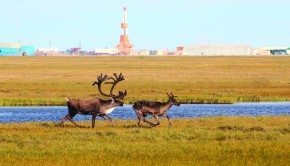Easing Earth’s Rising
The Right Steps Now Can Avert the Worst of It
“We’re not going to stop global warming; it’s too late for that. But we can keep it from getting as bad as it could possibly get.”
~ Bill McKibben
Renowned climate scientist Richard Somerville, Ph.D., uses simple language and sports analogies to help us understand climate change and the risks ahead.
A distinguished professor emeritus, researcher at California’s Scripps Institution of Oceanography and author of The Forgiving Air, he likens greenhouse gases to a scandal that’s rocked major league baseball in recent years. “Greenhouse gases are the steroids of the climate system,” he says. Although we can’t link them to any single weather event, we can see them in the statistics at the end of the season, Somerville says. With the bases loaded, “Look out, because Mother Nature bats last.”
To explain how we could confront the problem, he turns to another sport, skiing. If we were serious about avoiding a worst-case scenario, we would have opted for the “bunny slope” approach, a leisurely descent from the ubiquitous use of climate-changing fossil fuels. Unfortunately, greenhouse gases would have had to peak two years ago and now be in decline in order to take the easy way out. Instead, the amount of carbon dioxide in the atmosphere shot past 400 parts per million last May, a level that most scientists agree the planet hasn’t experienced since long before the arrival of modern humans.
“Science tells you, you can put this much carbon dioxide into the atmosphere, but no more,” without changing the planet’s climate too dramatically, Somerville says. “Mother Nature tells you, you cannot wait 50 or 100 years to solve this. You have to do it in five to 10 years. There’s been a general failure to connect the dots.” The bit of good news is that time has not yet completely run out. He and other pioneering thought leaders believe that we can still reverse the dangerous current course.
“These next few years are going to tell the tale about the next 10,000 years,” well-known global environmental activist Bill McKibben, author of Eaarth: Making a Life on a Tough New Planet. “We’re not going to stop global warming; it’s too late for that. But we can keep it from getting as bad as it could possibly get.”
On the Energy Front
McKibben’s grassroots group, 350.org, opposes the planned Keystone XL pipeline that, if built, is expected to transport Canadian tar sands oil across the United States to refineries along the Gulf of Mexico. Increasing fossil fuel infrastructure, he says, is impractical, and we’d be better off investing in clean and renewable energies such as wind, solar and geothermal.
It’s a theme also sounded by Frances Beinecke, president of the New York City-based Natural Resources Defense Council and author of Clean Energy Common Sense. With the failure of the U.S. Congress to enact climate legislation, her group, encompassing 1.4 million online members and activists, is pressing the Obama administration to live up to its pledge to regulate the carbon dioxide emitted by power plants. The leading culprits for climate-changing gases, they contribute 40 percent of the country’s carbon emissions. “It’s time to act, and we have to act now,” Beinecke says.
On the Water Front
“Tell politicians that you care about this. We’ve got to get countering climate change high on the priority list.”
~ Richard Somerville
Sandra Postel agrees. “Water, energy and food production: These things are tightly linked, and all are affected by climate change.” From Los Lunas, New Mexico, she leads the Global Water Policy Project, a group also focused on the climate conundrum, as well as National Geographic’s Change the Course national freshwater conservation and restoration campaign.
Competition for water is increasing in several parts of the country, she says, and will only get worse as dry conditions increase demands on groundwater. Endangered sources detailed in her extensive related writings include the Ogallala Aquifer, vital to agricultural operations across much of the Great Plains, and California’s Central Valley, the nation’s fruit and vegetable bowl. In the Colorado River Basin, which provides drinking water to some 30 million people, water demands already exceed the available supply—and that gap is expected to widen with changes in the region’s climate.
In other regions, the problem is too much water from storms, hurricanes and flooding, a trend that Postel and other experts say will also worsen as the world continues to warm and fuel weather extremes. Beyond the loss of lives and property damage, this “new normal” holds stark implications for communities.
“We’ve built our bridges, dams and other infrastructure based on 100-year records of what’s happened in the past,” advises Postel. “In a lot of ways, how we experience climate change is going to be through changes in the water cycle. If the past isn’t a good guide to the future anymore, we’ll have to change our water management.” (See nrdc.org/water/readiness by city and state.)
On the Ocean Front
“Water, energy and food production: These things are tightly linked, and all are affected by climate change.”
~ Sandra Postel
The world’s oceans are being transformed by climate change in ways we are only beginning to understand. Since the Industrial Revolution, oceans have absorbed a significant portion of the carbon dioxide generated, experiencing a 30 percent rise in acidity; that’s expected to reach 100 to 150 percent above pre-industrial levels by the end of this century, according to the nonprofit National Academy of Science (NAS), in Washington, D.C.
“Thank goodness for the oceans, but they are paying a tremendous price,” says Oceanographer Dawn Wright, Ph.D. She’s chief scientist of Esri, in Redlands, California, that analyzes geographic system relationships, patterns and trends.
The higher acidity levels are “taking a toll on shellfish such as oysters, clams and sea urchins, as well as coral reefs, where much aquatic life is spawned,” Wright explains. Climate change may have other devastating impacts on the ocean food chain—and eventually us—that scientists are only beginning to discern. As just one of myriad impacts: Ocean acidification threatens the country’s $3.7 billion annual wild fish and shellfish industry and the $9.6 billion slice of the global tourism business that caters to scuba divers and snorkelers, according to a recent NAS study.
The Way Forward
“Thank goodness for the oceans, but they are paying a tremendous price.”
~ Dawn Wright
We can be grateful for some hopeful developments in the call to act.
Wright, who has advised President Obama’s National Ocean Council, is overseeing her company’s ocean initiative, which includes building an ocean basemap of unparalleled detail. While less than 10 percent of the world’s oceans’ underwater realms are mapped today, Esri is compiling authoritative bathymetric data to build a comprehensive map of the ocean floor. Public and private sector planners, researchers, businesses and nonprofits are already using this map and analysis tools to, among other things, conduct risk assessments and provide greater understanding of how onshore development impacts oceans’ natural systems.
Municipalities are also taking action. New York City plans to restore natural buffers to future hurricanes, while Philadelphia and other cities are restoring watersheds, replanting trees in riparian areas, adding rain gardens, laying permeable pavement and revamping roofs and parking lots to reduce stormwater runoff. Investing in such “green infrastructure” is less costly than expanding “grey infrastructure” such as underground sewer systems and water purification plants.
Increasingly, local authorities are relocating communities out of flood zones to allow rivers to reclaim wetlands, an effort which also creates new recreation and tourism spots. Floodplains buffer against extreme flooding and drought, plus filter stormwater runoff, removing farm and lawn fertilizers and other chemicals that otherwise enter waterways, creating deoxygenated “dead zones” where aquatic life can’t survive, as exemplified by parts of Lake Erie, Chesapeake Bay and the Gulf of Mexico.
“These solutions are unfolding here and there,” Postel notes, while also remarking that too many locales are rebuilding levees at their peril and allowing people to return to areas that flood repeatedly. “An amount of climate change is already locked in. We will have to adapt, as well as mitigate, simultaneously.”
Somerville, who helped write the 2007 assessment by the Nobel Prize-winning International Panel on Climate Change, labels it “baloney” when politicians say there’s not enough time or it’s too expensive to address the problem. “It’s very doable,” he maintains. “First, inform yourself. Second, tell politicians that you care about this. Then raise hell with those who don’t agree. We’ve got to get countering climate change high on the priority list.”
McKibben recommends that the country gets serious about putting a price on carbon emissions. Meanwhile, he’s encouraged by the people-powered regional successes in blocking fracking, a controversial method of extracting natural gas, and credits grassroots groups for holding the Keystone pipeline project at bay.
“We’re cutting it super-close” and need to change the trajectory of climate change, according to McKibben, who says we can still have good lives powered by wind and solar, but will have to learn to live more simply. “I don’t know where it will all end and won’t see it in my lifetime. But if we can stop the combustion of fossil fuels and endless consumption, then there’s some chance for the next generation to figure out what the landing is going to be.”

Signs Of Changes To Come
Without actions to significantly curb greenhouse gas emissions, air temperatures could increase as much as 11.5 percent by 2100, according to the U.S. Environmental Protection Agency (EPA).
While the United Nations Framework Convention on Climate Change pledged in 2009 to keep warming from increasing more than 3.6 degrees Fahrenheit, more recent reports by the World Bank and other institutions warn that the goal may be unrealistic. Continued global warming could cause widespread drought, flooding and other changes, with disastrous consequences. Here are some of the ways climate change has already impacted our lives.
Temperatures: The average global temperature for 2012—about 58.3 degrees Fahrenheit—was the ninth-warmest year since record keeping began in 1880. It was also the 36th consecutive year that the global temperature surpassed the 20th-century average, according to the National Climate Data Center at the National Oceanic and Atmospheric Administration. The problem comes alive in a video at Tinyurl.com/NASAEarthTemps.
The EPA reports that the number of days that temperatures will exceed 90 degrees Farenheit is expected to
increase throughout the U.S., especially in areas that already experience heat waves.
Drought: Drought struck two-thirds of America’s lower 48 states last year, and continued into 2013 in many parts of the country, costing billions of dollars in crop failures and damage from resulting wildfires.
Extreme storms: East Coast weather has become wilder, with storms such as Hurricane Irene and Superstorm Sandy wreaking unprecedented losses in human life and property.
Freshwater supplies: As melting shrinks glaciers’ historic footprints, reducing the amount of springtime snowmelt, and we continue to deplete groundwater faster than it can be replenished, conflicts between agriculture, industry and municipalities over water are expected to increase. Meanwhile, rising sea levels near some seashore cities have already led to incursions of saltwater, contaminating underground freshwater systems.
Rising sea levels: Since 1870, the global sea level has risen by about eight inches, according to the EPA. By the end of this century, it estimates that New York City could see a rise of 2.3 feet and Galveston, Texas, 3.5 feet. Other studies say those estimates are conservative. Research published in the Proceedings of the National Academy of Sciences in July concluded that a rise of 3.6 degrees Fahrenheit could result in a corresponding rise in sea levels exceeding 13 feet.
<












